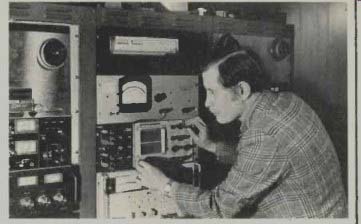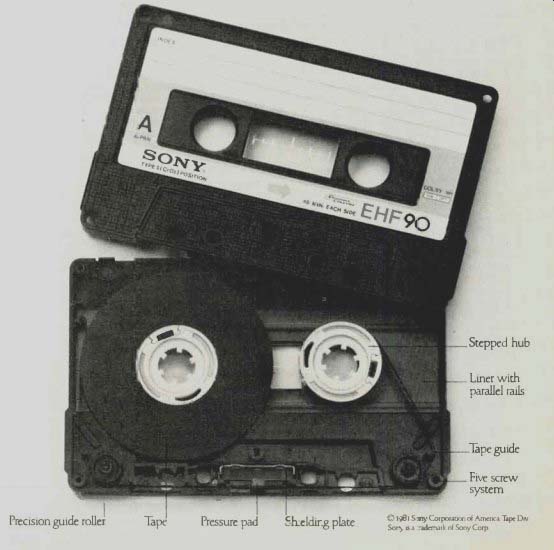
by Craig Stark
Digital Cassettes
Q. I wonder why no one has come out with digitally recorded cassettes? These would be more versatile than discs and more accurate than the best of today's analog recordings.
-DAVID A. WILSON Arlington, Mass.
A. The idea of the digitally recorded cassette is attractive, but there are several problems that have to be solved first. Information-packing density is one. To put enough "bits" on the tape to equal or improve on conventional analog recording demands a bandwidth (frequency response) about equal to that of a video recorder which, incidentally, is why PCM (digital) adaptors for home use have all required a video recorder. One way around the bandwidth problem is to record each bit within a digital "word" on a physically separate track, or at least to split up the fourteen- or sixteen-bit digital words among several different tracks on the tape. The 3M and Mitsubishi open-reel digital machines (designed to use 1/4-inch videotape) that I've seen both do this. The new Mitsubishi X80--yours for a mere $25,000--uses a total of ten tracks (eight for the audio signals, two for control purposes) for two audio channels and runs at 30 ips. Compare that to a less than 1/4-inch tape running at 1 7/8 ips and you can start to appreciate the problem of a digital-cassette format.
There is a further difficulty with the standard cassette as a digital-recording medium. The mechanical stability of cassette shells and guidance mechanisms is simply not up to digital requirements. Enormously complex "error-correction" systems would be needed-far more so than with open-reel digital recorders.
There is an attractive existing alternative to the VCR-based home digital system, however, and that is the almost-forgotten Elcaset format. Its slightly wider tape and 3 3/4-ips speed are closer to the digital track/ bandwidth requirements, and because the guidance system for an Elcaset (unlike a cassette) is not dependent on the shell, it can be made as stable and precise as needed. If I were looking for a practical alternative to the VCR format for home digital-audio taping, that's where I'd start my investigation.
Metal Playback
Q. My cassette deck does not have a switch position for metal tape, but I was told that I could still play, though not record, such tapes. However, when I play a metal tape recorded on a friend's deck the right channel occasionally "drops out" or becomes muffled. What's the problem?
-D. SCOTT FERGUSON; Kent, Ohio
A. You were told correctly: if your deck lacks a "metal" switch position you cannot successfully record such tapes, but you should be able to play them back using the CrO2, switch position.
Your problem in playing back the tapes recorded by your friend has nothing to do with their being metal. The likelihood is that there is some very slight incompatibility in head adjustments and/or cassette hold-down arrangements between the two decks. Despite every attempt to make cassettes interchangeable from one deck to another, there can be occasional problems when one unit is toward the high side of the allowable tolerance while the other is toward the low side. The variations within tolerances in the cassette shells themselves are another possible factor in decreasing compatibility.
Transport Controls
Q. Is there any difference in quality at between mechanically operated, solenoid-operated, and motorized-cam-operated cassette transports? Also, what is TTL control?
-NICK STASSIO; New York, N.Y.
A. A well-designed mechanically operated transport-control mechanism will outperform a badly engineered solenoid system, and several recent decks have incorporated mechanical pushbuttons that are far easier to use than the traditional "piano keys." A mechanical system, however, is inherently more complex and therefore harder to design well than one based on electrical solenoids. And since higher prices can be charged for solenoid-controlled decks, the probability favors good design (with some exceptions) in them. Solenoids also provide the option of remote control.
Solenoids are not free of problems, how ever. For one thing, they tend to clank, sometimes rather loudly, when they operate. This noise reflects a shock to the parts being moved by the solenoid, one of which is the tape-head/pinch-roller assembly, and it has been alleged that these repeated shocks may, in time, put the heads out of alignment. So as to combine the convenience of light-touch pushbutton control with a more gentle mechanical action, therefore, a few rather expensive decks use a small motor that activates a series of gently operating cams to bring the heads up to the tape, control the brake mechanism, etc. In the abstract, this is probably the "best" way of controlling the transport, but the cost is sufficiently high to make it justifiable only in a few machines.
The phrase "TTL" stands for "transistor-transistor logic," a type of integrated-circuit technology. With a purely mechanical transport it's possible to arrange the levers so that potentially destructive operations-such as going directly from high speed rewind into play before the tape stops-can be precluded. With electrically controlled transports the safety interlock must be electrical, which is what the TTL circuitry is for. It senses the machine's transport status at any moment and delays the execution of a "dangerous" command until the proper intervening steps have taken place.

C-120 Cassettes
Q. I understand that at one time many recorder manufacturers warned that C-120 (two-hour) cassettes should not be used on their decks. Why isn't there a problem in all cases? What causes the problem? Is the warning still valid?
- PETER MARKOFF St. Louis, Mo.
A. The warning is still appropriate. The longer the tape enclosed within a cassette shell, the thinner it must be, and the only way to reduce tape thickness is by using thinner plastic base material or a thinner magnetic coating. Experience indicates that C-60 and C-90 cassette tape can have the same coating thickness if there is a tolerable reduction in the base-film thickness of the latter. For a C-120 tape to fit into a standard shell, however, requires both a thinner magnetic coating and a still further thinning of the plastic base. Such super-thin tape provides inferior sonic performance, and there is a serious increase in the likelihood of its slipping or jamming in many decks.
Improvements in both cassette-deck transports and cassette housings have certainly reduced the purely mechanical draw backs of C-120s, but they are still risky at best, and the sonic loss remains. You may get away with using them, but you're courting trouble.
Also see:
Editorially Speaking [May 1978]
Source: Stereo Review (USA magazine)